A Research project on “Advertising Effectiveness On Soft Drink Company Coca Cola” was submitted by Akash Prabhat (from Galgotias University Greater Noida, Uttar Pradesh) to extrudesign.com.

INTRODUCTION
Advertising Effectiveness
The objectives of all businesses are to make profits and a merchandising concern can do that by increasing its sales at remunerative prices. This is possible if the product is widely polished to be audience the final consumers, channel members and industrial users and through convincing arguments, it is persuaded to buy it. Publicity makes a thing or an idea known to people. It is a general term indicating efforts at mass appeal. As personal stimulation of demand for a product service or business unit by planting commercially significant news about it in a published medium or obtaining favourable presentation of it upon video television or stage that is not paid for by the sponsor.
On the other hand, advertising denotes a specific attempt to popularize a specific product or service at a certain cost. It is a method of publicity. It is always intentional openly sponsored by the sponsor and involves certain costs and hence is paid for. It is a common form of non-personal communication about an organization and or its products idea service etc. that is transmitted to target audiences through a mass medium. In common parlance, the terms publicity and advertising are used synonymously.
What is advertising?
The word advertising is derived from the Latin word viz, “advertiser” “ad” meaning towards and “verto” meeting towards and “verto” meaning. “I turn” literally specific thing”. Simply stated advertising is the art “says green.” Advertising is a general term for and all forms of publicity, from the cry of the street boy selling newspapers to the most celebrate attention attracts device. The object always is to bring to public notice some articles or service, to create a demand to stimulate buying and in general to bring together the man with something to sell and the man who has means or desires to buy”.
Advertising has been defined by different experts. Some of the quoted definitions are:
American marketing association has defined advertising as ―any paid form of non-personal presentation and promotion of ideas, goods or services by an identified sponsor. The medium used are print broad cast and direct.
Stanton deserves that ―Advertising consists of all the activities involved in presenting to a group a non- personal, oral or visual openly, sponsored message regarding a product, service, or idea. This message called an advertisement is disseminated through one or more media and is paid for by the identified sponsor.
Advertising is any paid form of non – personal paid of presentation of ideas goods or services by an identified sponsor.
Advertising is a “non- personal paid message of commercial significance about a product, service or company made to a market by an identified sponsor.
In developing an advertising programme, one must always start by identifying the market needs and buyer motives and must make five major decisions commonly referred as 5M (mission, money message, media and measurement) of advertising.
Basic Features of Advertising
On the basis of various definitions it has certain basic features such as:
- It is a mass non-personal communication.
- It is a matter of record.
- It persuades buyers to purchase the goods advertised.
- It is a mass paid communication.
- The communication media is diverse such as print (newspapers and magazines).
Functions of Advertising
For many firms advertising is the dominant element of the promotional mix – particulars for those manufacturers who produce convenience goods such as detergent, non – prescription drugs, cosmetics, soft drinks and grocery products. Advertising is also used extensively by maters of automobiles, home appliances, etc, to introduce new product and new product features its uses its attributes, pt availability etc.
Advertising can also help to convince potential buyers that a firm‘s product or service is superior to competitor‘s product in make in quality, in price etc. it can create brand image and reduce the likelihood of brand switching even when competitors lower their prices or offer some attractive incentives.
Advertising is particularly effective in certain other spheres too such as:
- When consumer awareness of products or services is at a minimum.
- When sales are increasing for all terms in the industry.
- When a product is new and incorporates technological advances not strong.
- When a primary buying motive exists.
It performs the following functions:
- Promotion of sales
- Introduction of new product awareness
- Mass production facilitation
- Carry out research
- Education of people
- To make sound future decisions
- To impress upon the top management
- To know the point of saturation
- To keep in touch with the new trends
Types of Advertising
Broadly speaking, advertising may be classified into two categories viz., product and institutional advertising.
- Product Advertising: The main purpose of such advertising is to inform and stimulatethe market about the advertiser‘s products of services and to sell these. Thus type of advertising usually promotes specific, trended products in such a manner as to make the brands seam more desirable. It is used by business government organization and private non-business organizations to promote the uses features, images and benefits of their services and products. Product advertising is sub-divided into direct action and indirect action advertising, Direct action product advertising wages the buyer to take action at once, ice he seeks a quick response to the advertisement which may be to order the product by mail, or mailing a coupon, or he may promptly purchase in a retail store in response to prince reduction during clearance sale.
- Institutional Advertising: It is designed to create a proper attitude towards the sellers tobuild company image or goodwill rather than to sell specific product or service. Its purpose is to create a frame of mind and to implant feeling favorable to the advertisers company. Its assignment is to make friends for the institution or organization.
It is sub-divided into three categories: patronage, public, relations and public service institutional advertising.- In patronage institutional advertising the manufacturer tells his prospects and customer about himself his policies and lives personnel. The appeals to the patronage motivation of buyers. If successful, he convinces buyers that his operation entitles him to the money spent by them.
- Public relations institutional advertising is used to create a favorable image of the firm among employees, stock-holders or the general public.
- Public service institutional advertising wages public support.
- Other Types: The other types are as follows:
- Consumer advertising
- Comparative advertising
- Reminder advertising
- Reinforcement advertising
Advertising Objective
The long term objectives of advertising are broad and general, and concern the contribution advertising should make to the achievement of overall company objectives. Most companies regard advertising main objective as hat of proving support to personal selling and other forms of promotion. But advertising is a highly versatile communications tools and may therefore by used for achieving various short and long term objectives. Among these objectives are the following:
- To do the entire selling job (as in mail order marketing).
- To introduce a new product (by building brand awareness among potential buyers).
- To force middlemen to handle the product (pull strategy).
- To build brand preference 9by making it more difficult for middleman to sell substitutes).
- To remind users to buy the product (retentive strategy).
- To publicize some change in marketing strategy (e.g., a price change, a new model or an improvement in the product).
- To provide rationalization (i.e. socially acceptable excuses).
- To combat or neutralize competitors’ advertising.
- To improve the morale of dealers and/or salespeople (by showing that the company is doing its share of promotion).
- To acquaint buyers and prospects with the new uses of the product (to extend the PLC).
Designing advertising campaign:
Advertising is an organized series of advertising messages. It has been defined as “a planned, co-ordinate series of promotional efforts built around a central theme and designed to reach specified goals.” In other words, it is an orderly planned effort consisting of related but self–contained and independent advertisements. The campaign may appear in one more media .it has a single theme or keynote idea and a single objective or goal. Thus, “a unified theme of content provides psychological continuity throughout the campaign while visual and oral similarities provide physical continuity. In the short run, all campaigns want a pre-determined psychological reaction,s in the long run, practically all campaigns have sales goals.
The series of advertisements used in the campaign must be integrated with the sales promotional efforts and with the activities of the sales force. Campaign varies in length some may run only for a few days, other for weeks, yet other for a season or the entire year. Usually a range of 3 to 6 months includes many campaigns. Many factors influences campaign length such as competitors advertising media, policies, seasonal falls curves of the product involved, the size of the advertising funds, campaign objectives and the nature of the advertisers marketing programme.
Objectives of campaign
The advertising campaign, especially those connected with the consumers aims at achieving these objectives:
- To announce a new product or improve product.
- To hold consumers patronage against intensified campaign use.
- To inform consumers about a new product use.
- To teach consumers how to use product.
- To promote a contest or a premium offer.
- To establish a new trade regional, and
- To help solve a coca regional problem.
The institutional advertising campaigns on the other hand, have these objectives.
- To create a corporate personality or image.
- To build a company prestige.
- To keep the company name before the public.
Stages in an advertising campaign:
Several steps are required to develop an advertising campaign the number of stages and exact order in which they are carried out may vary according to organizations resources, the nature of its product and the types of audiences to be reached. The major stages/stepsare:
- Identifying and analyzing the advertising.
- Defining advertising objects.
- Creating the advertising platform.
- Determining the advertising appropriation.
- Selection media plan.
- Creating the advertising message.
- Evaluating the effectiveness of advertising.
1. Identifying & Analyzing the Advertising target: Under this step it is to decide as to whom is the firm trying to reach with the message. The advertising target is the group of people towards which advertisements are aimed at four this purpose complete information about the market target i.e. the location and geographical location of the people, the distribution of age, income, sex, educational level, and consumers attitudes regarding purchase and use both of the advertising product and competing products is needed with better knowledge of market target, effective advertising campaign can be developed on the other hand, if the advertising target is not properly identified and analyzed the campaign is does likely to be effective.
2. Determining the advertising objectives: The objectives of advertisement must be specifically and clearly defined in measurable terms such as “to communicate specific qualities about a particulars product to gain a certain degree of penetration in a definite audience of a given size during a given period of time”, increase sales by a certain percentage or increase the firms market shares.”
The goals of advertising may be to:
- Create a favorable company image by acquainting the public with the services offered available to the employees and its achievements.
- Create consumers or distributor awareness by encouraging requests providing information about the types of products sold; providing information about the benefits to be gained from use of the company’s products or services; and indicating how product (or services) can be used.
- Encourage immediate sales by encouraging potential purchasers through special sales contests, getting recommendation of professional people about company’s products etc.
- It secures action by the reader through associating ideas, repetition of the same name in different contexts, immediate action appeal.
3. Creating the Advertising Platform: An advertising platform consists of the basic issues or selling points that an advertiser wishes to include in the advertising campaign. A single advertisement in an advertising campaign may contain one or more issues in the platform. A motorcycle producers advertising platform should contain issues which are of importance to consumers filling and such issues also be those which the competitive product do not posses.
4. Determining the Advertising Appropriation: The advertising appropriation is the total amount of money which marketer allocates. For advertising for a specific time period. Determining the campaign budget involves estimating now much it will cost to achieve the campaigns objectives. If the campaign objectives are profit relating and stated quantitatively, then the amount of the campaign budget is determined by estimating the proposed campaigns effectiveness in attaining them. If campaigns object is to build a particular type of company image, then there is little basis for predicting either the campaigns effectiveness or determining the budget required.
5. Selecting the Media: Media selection is an important since it costs time space and money various factors influence this selection, the most fundamental being the nature of the target market segment, the type of the product and the cost involved. The distinctive characteristics of various media are also important.
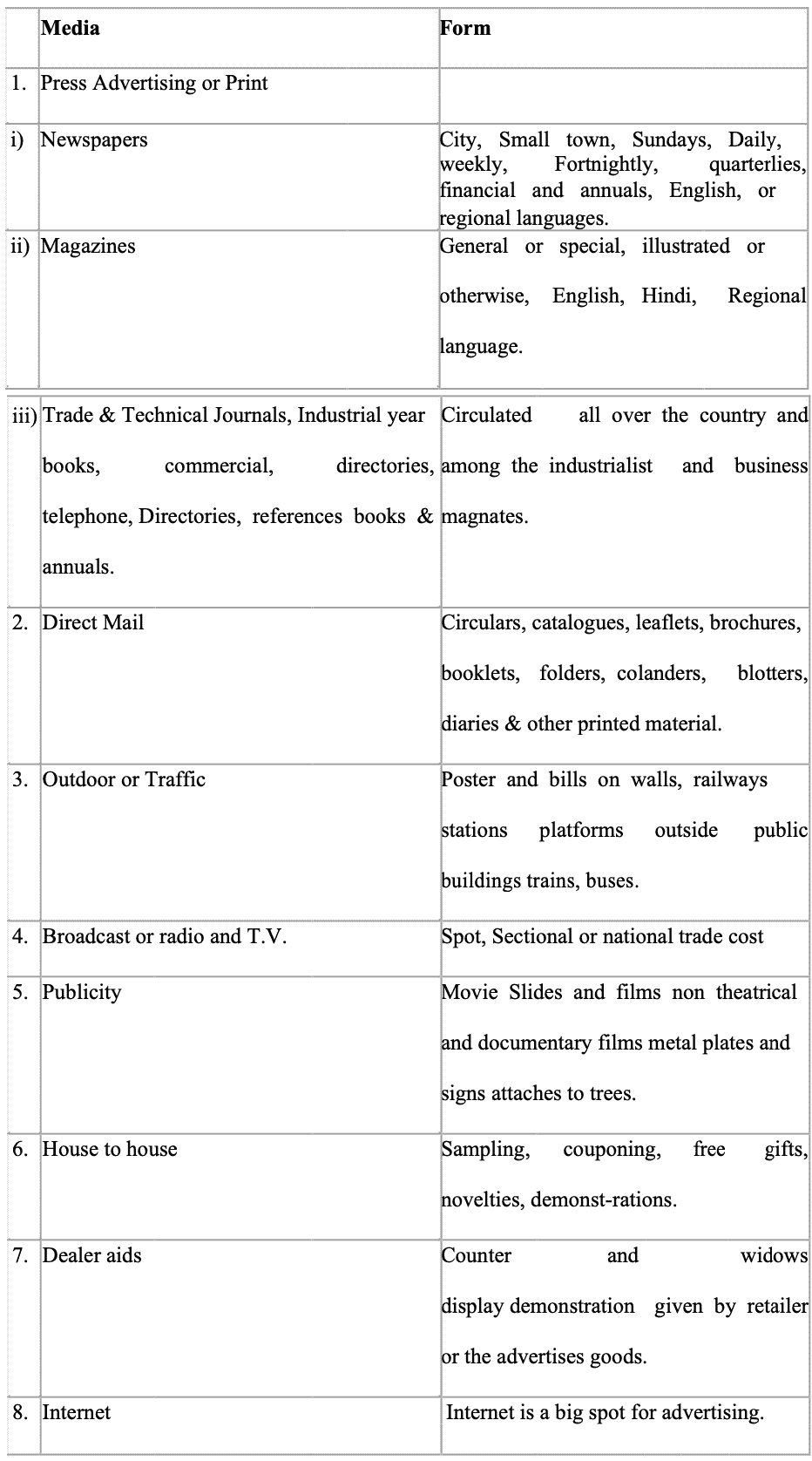
6. Creating the Advertising Messages: This is an important stage of advertising campaign. The contents of the message have to be very carefully drafted in the advertisement. Characteristics of person in the advertising target influence the message content and form. Advertisers must use words, symbols and illustration that are meaningful, familiar and attractive to those persons. The type of media also influences the content and form of the message.
7. Evaluating the Effectiveness of Advertising: The effectiveness of advertising is measuredfor a variety of reasons:
- To determine whether a campaign accomplished its advertising objects.
- To evaluate the relative effectiveness of several advertisements to ascertain which copy, illustrations or layout is best.
- To determine the strengths and weaknesses of various media and media plans.
In other words, measuring advertising effectiveness is needed to determine whether the proposed advertisements should be used and if they will be now they might be improved; and whether going campaign should be stopped, continued or changed. In accomplishing these purposes, pretests and post test are conducted. The former tests before exposing target consumers to advertisements and the letter after consumers have been exposed to advertisements and the letter after consumers have been exposed to advertisements. For an effective advertising programme, the advertising manager requires a basic understanding of the medium that is going to carry it. For effectively using advertising the management must test advertising to know which of the advertisement have proved profitable and why as compared to others.
Advertising
The word ‗Advertising‘ has its origin from a Latin word ‗Adventure‘ which means to turn to. The dictionary meaning of the word is ‗to announce publicity or to give public concerned to a specific thing which has been announced by the advertiser publicity in order to inform and influence them with the ideas which the advertisement carries. In business world the terms in mainly used with reference to selling the product of the concern.Thus Advertisings:
- Impersonal
- A communication of ideas
- Aimed at mass audience
- By a paying sponsor
The two forms of mass communication that are something confused with advertising are publicity and propaganda. If we eliminate the elements of the “paying sponsor” (The paid requirement) we would have the element of publicity left: For publicity is technically speaking, advertisement without payment. In a similar manner. If we eliminate the requirement of an “identified sponsor”, the resulting communication is propagandistic.
METHODS OF ADVERTISEMENT
Electronic Media
Advertisers use two types of media to reach target consumers over the airwaves; radio or T.V.
Radio:
Advertisers using the medium of radio may also be classified as National or Local advertisers. The radio is a prominent vehicle of advertising in our country and accounts for a large sum of the total advertising budget.
The radio serves principally local rather than national or large regional markets. Many small advertisers use the radio. So do some large organizations.
Television:
Late in India, a growing class of advertising media has been the TV. In our country, commercial advertising on TV is severely limited because broadcast timings are only in the evenings. The TV is a unique combination of timing of sight and sound and achieves a deeper impact than the other media do. This is particularly advantageous for advertisers whose product require demonstration. TV advertising offers the advantage of impact, mass coverage, repetition, flexibility and prestigious. In our country not everyone has a TV set; therefore it does not reach everyone. Moreover, in rural India where 76.31% of our population lives. There are hardly any TV sets, except at the community centres where electricity is available. Moreover, TV programmes in our country do not offer much selectivity. The translation is limited; any centers do not have TV towers.
TV appeals to both the senses of sound and of sight. As a result is combines the two to produce high-impact commercials. Finally, the fact that product or service is promoted on TV may build a prestigious image of the product and its sponsor. The pleasure derived from watching TV is at least potentially transferable to the advertising message delivered through the medium.
Print Media
The print media carry their massages entirely through the visual mode. These media consist of newspapers, magazines and direct mail.
Newspaper:
A sizable share of the total advertising budget is spent on advertising in newspapers.
Newspapers in our country virtually reach most of the homes in the cities. Since newspapers are local, marketers can easily use them to reach particular markets. This selectivity is easily supply news, they offer an atmosphere of factual information and of currency that may be favorable for some advertising situations. Advertisers can reach a very broad audience through rigorous. Some are in the twelve-hour range. From the viewpoint of the advertiser, newspaper offers several advantage, they are local in content and appeal and provide opportunity for direct communication between a product and its local dealers or distributors. Because newspapers newspapers which offer great flexibility. The advertisers may choose the specific area to be covered and the advertisement can be placed in newspapers at very short notice as compared with other media.
Magazines:
Magazines are also mean of reaching different market, both original and matinal and of general and specific interest. An organization may approach national markets through such publication as Business India, Famina, and Sports week, India Today, Business World and Filmfare. Some marketers divide their market on the basis of such variable as age, educational level and interest magazines. Magazines are divided into those parts that serve business, industrial consumers, ladies, sports etc. The diversity of magazines is tremendous. Some offer news or together “General Interest” content to huge audience. Others are highly specialized, technical or even exotic. In general, magazines offer advertiser the opportunity to reach highly selective audience.
OUTDOOR AND TRANSIT MEDIA
Outdoor Advertising
Outdoor advertising involves the use of sign and bill-boards, posters or displays (such as those that appear on a building‘s wall) and electric spectacular (large, illuminated, sometime animated sign and display). The marketers may purchase billboards on the basis of showings. A showing indicates the percentage of the total population of a particular geographic area that will be exposed to it during one month period. The highest showing is 100.
Here the number of billboards is would attract approximately 50% of the local population about 20 times during a month. Sings are usually smaller than billboards and are erected and maintained by the marketer rather than by the advertising media.
Transport Advertising:
Transport advertising appears on the inside or outside of taxis,buses, railways and other modes of passenger transportation. Marketers may use transit advertisement to attain high exposure to particular group‘s consumers on theory way to and from work and tourists. Repeat exposure is possible for a majority of the people in our country use public transport basis. Transport advertising is useful in reaching consumers at an advantageous point which they are embarking on a shopping trip. This medium is a low-cost medium.
Sales Promotion
According to the American Marketing Association, Sales Promotion consists of those marketing activities other than personal advertising and publicity that stimulate consumer purchasing and dealer effectiveness, such as displays shows and expositions, demonstration and various non- recurrent selling efforts not in the ordinary routine. Sales promotion activities are impersonal and usually non-recurring and are directed at the ultimate consumers, industrial consumers and middlemen. These activities tend to supplement the advertising and personal selling efforts. Examples of sales promotion are free product samples, trading stamps, store displays, premiums, coupons and trade shows. For many organizations, including the marketers of food, toys and clothing, store displays are an important sales promotion device. Display exposes the promotion messages to consumers at the time and place of purchase. Such exposure is especially important for items that are bought on impulse. Numerous consumers‘ products are purchased in stores that use self-service selling methods. Marketers of such items need effective display in order to distinguish their products from those of their rivals.
Publicity
Publicity is a means of promoting the mass market and is similar to advertising, except that it is free, is found in the editorial portion of news media and pertains to newsworthy events. The most common type of publicity are news release (also known as press release), photographs and feature stories. Marketers have less control over the nature of the publicity that their organizationand products receive than they have over their advertising, personal selling and sales promotions messages. Upon receiving a news release, for instance, the editor or broadcast station programme director may choose to throw the release in the waste paper basket, change the hoarding, or print or broadcast it in the original form. The disposition of the news release is entirely in the hands of the media and cannot be dictated by the marketer. Publicity may be negative as well as positive. Some products and brands have received bad publicity; for example cigarettes, wings, artificial sweeteners have been branded unsafe or unhealthy in the publicity which they would rather have done without. Many a companies and trade association officials attempt to develop favorable working relationships, with the media in order to minimize bad publicity. They realize that such communications to the public may have every adverse impact upon the image of the organization.
Personal Selling
Personal selling consists of persons to communication between the sales persons and their prospects. Unlike advertising, it involves personal interactions between the sources and the destination. Advertising aims at grouping the shotgun approach, while personal selling aims at individuals the right approach. Sales persons are in the position to tailor their messages according to the unique characteristics of each prospect. Further, by observing and listening, sales persons receive immediate feedback on the extent to which their messages are getting across. If feedback indicates that the message is not getting across, the sales person may quickly adjust it or the method of its presentation. Personal selling may be a very intense means of promotion. Consumers can easily leave the room-during a TV commercial, ignore a store display. The most effective method of promotion probably is to have sales person provided that the organization has sufficient funds. The most effective method of promotion probably is to have sales person call upon every target consumers, for many institutions, especially those that appeal to the mass market, this would be terribly inefficient. As a result, they employ mass marketing techniques such as advertising, personal selling is very important in industrial marketing.
Public Relations
Marketers engage in public relations in order to develop a favorable image of their organization and products join the eyes of the public. They direct this activity to parties other than target consumers. These “other” include the public at large labor unions, the press and environmental groups. Public relations activities include sponsoring, lobbying and using promotion message to persuade members of the public to take up a desired position. The term public relations refer to a firm’s communication and relationships with the various sections of the public. These sections include the organization customers, suppliers, share holders, employees, the government, the general public and the society in which the organization operates. Public relations programme may higher be formal or informal. The critical point is that every organization, whether or not it has a formalized organized, programme, should be concerned about its public relations.
INTRODUCTION OF COMPANY
Brands of Coca-Cola
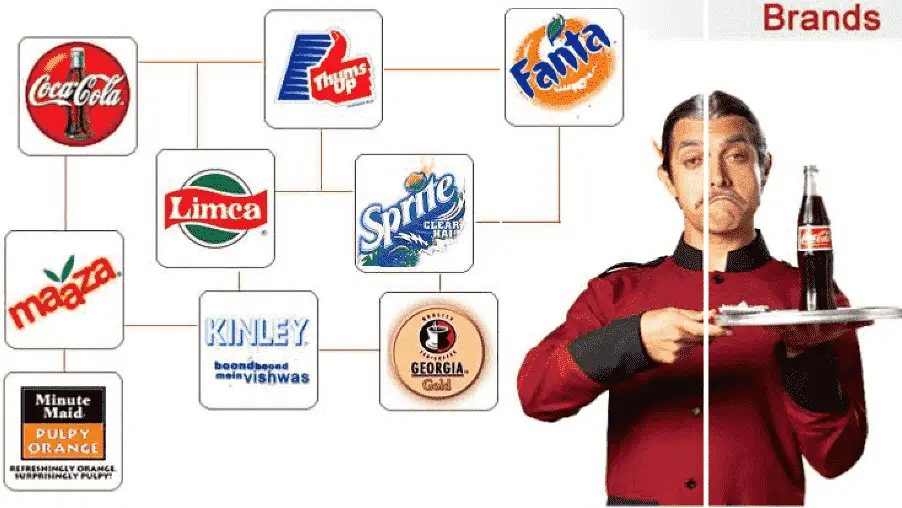
Coca-Cola | Thums Up | Fanta | Limca | Sprite | Maaza | Kinley | Georgia | Minute Maid
Flavours of the brand:
- Cola
- Lemon
- Soda
- Orange
- Mango
- Clear Lemon
Size of the cold drinks available in market
- 200 ml Bottles (RGB Glasses)
- 300 ml Bottles (RGB Glasses)
- 500 ml Bottles (RGB Glasses)
- 1Litre (PVC Bottles)
- 1.5 Liter (PVC Bottles)
- 2Liter (PVC Bottles)
Sales of Coca Cola Cold drinks
| Coca Cola Cold drinks | Weekly (in carets) | Monthly (in carets) | Yearly (in carets) |
| Coca Cola | 520 | 1840 | 22400 |
| Fanta | 250 | 1030 | 12900 |
| Thums-up | 350 | 1350 | 18500 |
| Limca | 380 | 1210 | 16300 |
| Maaza Tetra | 80 | 380 | 6200 |
| Sprite | 70 | 280 | 5000 |
| Maaza | 120 | 690 | 10000 |
(Primary data)
There is more consumption of Coca Cola and has 70% market share in the Yamunanagar city and Coca Cola is having maximum consumption and after that Thumps-up and after it Limca cold drink in the market and all the products has good sale but less than these.
Sales of Pepsi Cold drinks
| Pepsi Cold drinks | Weekly (in carets) | Monthly (in carets) | Yearly (in carets) |
| Pepsi | 430 | 1750 | 21600 |
| Mirinda Lemon | 390 | 1180 | 15400 |
| Mirinda Orange | 245 | 1000 | 13600 |
| Pepsi Soda | 126 | 470 | 6000 |
| Pepsi Apple | 120 | 400 | 5000 |
(Primary Data) The consumption of Pepsi cola, after this sale of Mirinda Lemon is there and after it Mirinda Orange is there and the market share is less of Pepsi in comparison of Coca Cola.
OBJECTIVES
OBJECTIVE OF THE STUDY
Following are the objectives of the study:
- To study the perception of consumer towards Coca-Cola.
- To find out effectiveness of various advertising tools
- To knowsthe most effective media of advertisement.
- To study the behavior pattern of target customer of Cola-Cola.
- To find out the most popular slogan of advertisement regarding cold drinks.
- To determine the factor, which persuade the retailer for sale of Coca-Cola.
- To find out the company‘s position in the soft drink market.
- To find out the exclusive outlets of Coca-Cola and its competitors.
- To find out the promotional activities of Coca-Cola.
- To identity the organizational features of Coca-Cola.
- To find out the promotional activities of competitors.
- To learn the strategy of Coca-Cola and its competitor.
- To try and understand the distribution channel system.
- To make suggestion and recommendations based on the findings of the study
- To find out the customer‘s perception of COKE as a brand
IMPORTANCE OF STUDY
The importance of this research is to know the most effective media of advertisement, to find out the reasons for liking the advertisement of cold drinks, to find out the most popular slogan of advertisement regarding cold drinks.
This study also helpful to know the purchasing decision of consumer by effect of advertisement and how advertisement helps the coca cola company to increasing their products sales in market by this study also helpful to know the reasons for liking the advertisement of cold drinks.
LITERATURE REVIEW
The term ―advertising‖ is defined as ―a paid non-personal communication from an identifiedsponsor using mass media to persuade or influence an audience‖ (Wells, Burnett & Moriarty, 2003). Among the other functions of advertising highlighted in this definition, the most important is the persuasion factor which is the consequence of the rest of the functions. An advertisement should have the potential to differentiate one product or service from others so as to produce a desired persuasive effect (Jeong, 2004).
If an advertisement does not produce the required impact, it can be assumed as ineffective and as such the substantial amount of money that companies spend on advertising their products goes waste. On the other hand, advertisements producing favorable impact can multiply the effectiveness of advertising expenditures. Hence, it implies that advertising plays a very crucial role in the effective functioning of an organization.Streams of Research on Advertising Effectivenessto assess the effectiveness of advertisements, there have been two streams of research (Jeong, 2004).
Market Response Approach of Advertising Effectiveness: The market response method of advertising effectiveness research assesses the impact of advertising in terms of the relationship between advertising expenditures and sales for the respective advertising brand during a particular period. However, advertising studies in market response analysis have resulted in conflicting findings. For instance, Telser (1962 cited in Kocabiyikoğlu, 2004) utilized the time series data for three different cigarette brands. Simultaneous equation models were used to explore the relationship between advertising and sales. The study found that different cigarette brands earn different return on advertising spending. Furthermore, Telser (1962) states that other marketing variables such as economic conditions and the level of competition in the market also influence the advertising-sales relationship (Kocabiyikoğlu, 2004). While studying the relationship between advertising and sales, Quandt (1964) also argued that other variables like disposable income, education etc. should be considered as these factors affect the advertising- sales relationship. Murphy and Cunningham (1993) state that linking advertising with sales impact is not appropriate as other marketing variables such as economic factors, market factors, etc., affect the company sale. In fact, previous research investigating the real effectiveness of advertising has not found clearlinkbetween advertising and its effect on company sale (Vakratsas and Ambler 1999). Neslin (2002) found that other variables like sales promotion can have a significant influence on the advertising and sales relationship and consider such variables responsible for inconsistent results in previous studies on the effectiveness of advertisements.
On the other hand, advertising researchers, exploring the psychological and behavioral impact of advertising, concentrate on the psychological factors such as recall, attitude towards the advertisement and brand, and purchase interest for the advertised brands (Jeong, 2004). According to this method, consumers are shown advertisements and then their responses on howthey perceive the advertisements are tapped. Furthermore, responses about their future behavior regarding the advertised brands are also recorded. Based on such responses from viewers, inferences are then made about the overall success or failure of the respective advertising campaign (Barban, Dunm, Krugman& Reid, 1990; Kover, Goldberg & James, 1995; Till &Back, 2005).
The behavioral perspective of advertising effectiveness provides insight into the antecedents of consumer behavior like attitude, recall and brand choice. It, therefore, supersedes in importance than the market and sales response method of advertising effectiveness. This is also more important as it is more consistent with the marketing concept which focuses on the final consumer as a fundamental business philosophy (Ang, Lee & Leong, 2007). Consistent with such views, Lucas and Britt (1963 cited in Kocabiyikoğlu, 2004) stated quite earlier that the basic purpose of advertising is to provide information about the actual receivers of advertisements that are instrumental in the selection of appropriate advertising strategies. This ultimately improves the effectiveness of advertisement and hence will positively affect the market result.
The behavioral perspective of advertising effectiveness concerns how people perceive, process, respond to, and use advertising information in making purchase decision about certain product or service (Jeong, 2004). As human psychology is complex, researchers have used various measures of advertising effectiveness. These include association among recall, recognition and attractiveness of advertisement (e.g., Wells, Burnett & Moriarty, 2003).
Effects of attention on memory (e.g., Raja ram, Srinivast& Travers, 2001), likeability as a measure of advertising effectiveness (Leather, McKechnie&Amirkhanian, 1994), recall, attitude towards the advertisement and brand (Ang& Low, 2000; Kover et al.,1995; Higie&Sewal, 1991).
However, the behavioral perspective of advertising effectiveness in general focuses on recall or and persuasion (Till &Baacks, 2005). There are many reasons why these two types of measures are consistently used as a useful criterion for evaluating advertising effectiveness: First, viewers‘ recall of the advertising information shows that the advertisement has been well attended to and the advertising information has got a place in consumers‘ minds which increases the likelihood of the advertised brand to become member of consumers‘ evoked set (Stewart, 1989). Evoked set represents the number of brands in the priority list of a consumer while considering purchase of goods and services (Loudon & Della Bitta, 2002). Recall is also of particular interest because an advertisement must first command attention before it can persuade. Hence, researchers have consistently used recall as a measure of advertising effectiveness (Till &Baack, 2005; Finn, 1992; Wells et al., 2003).
Similarly, attitude as another measure of advertising effectiveness is important because it is related to how consumers evaluate the advertised products. A strong positive attitude towards a product means that the person may buy the brand in future (Wells et al., 2003). As Mitchell and Olson (1981) state that as attitudes are relatively stable and enduring predispositions to behave, they should be useful predictors of consumers‘ behavior towards a product or service. Gresham and Shimp (1985) consider attitude as an attempt to influence consumers‘ choice. Hence, it implies that attitude has got a central place in consumer‘s brand choice. Attitudes are also important because they reflect the likes and dislikes of consumers (Wells et al., 2003). The importance of attitude can also be mainly understood from the empirical findings of studies stating that consumers‘ attitude towards advertisements affects their subsequent evaluation of the advertised brands and hence their choice of the respective brands (Mitchell & Olson, 1981). The above discussion reveals that both recall and attitude are the important measures of advertising effectiveness. Literature on the effectiveness of creative advertising also indicates that previous studies have used these measures as the common dimensions of advertising effectiveness. Since this study also covers the effects of creative advertising on consumers‘ advertisement and brand- related attitude as well as their recall and purchase intention for the advertised brands, each of these measures is discussed in the next section in detail. Advertising recall is a memo ability test that determines how viewers remember something specific about the advertisement and the brand (Wells et al., 2003). Recall can be aided as well as unaided (Till &Baack, 2005). In the aided recall test, participants are assisted to recall certain information by providing them with a relevant cue (Jeong, 2004). The relevant cue can be the respective product category for which the participant is being asked to recall (e.g., Milk, Cereal, etc.) or information about the purchase or usage situations in which a particular product type is used (e.g., Lunch , Breakfast, etc.). On the other hand, in the unaided recall test, participants are simply asked to recall and list the number of brands that appeared in the television commercials. As such, unaided recall is considered as a more challenging test of ‗memory trace‘ than aided recall (Till &Baack, 2005).
Therefore, in order to better understand the memo ability of creative advertisements, both aided and unaided recall were employed in this study. Recall indicates top of the mind awareness among consumers about an advertisement or brand, and advertisements with high recall are more likely to put the advertised brand in consumers‘ evoked set. (Stewart, 1989;Keller, 1993).Hence, recall is considered as the most common measure of advertising effectiveness among the advertising researchers (Kover et al., 1995; Higie&Sewal, 1991).
As a consequence, brands in consumers‘ evoked set are more likely to be considered at the time of consumers purchase decision (Loudon & Della Bitta, 2002). To understand the relative effectiveness of creative advertisements in terms of higher advertisement and brand recall, it is important to know how information is processed, stored and retrieved in human memory. For this purpose, review of the information processing model and the associative network model is given below. The information processing model of memory states that processing of incoming information is subject to limited processing capacity, that is, various levels of processing require different mental capacity allocation. If information requires deeper level of processing, it will require greater allocation of mental and cognitive capacity. On the other hand, lower level of processing requires less attention and hence less allocation of mental capacity (Craick& Lockhart, 1972). According to Craick and Lockhart (1972), information processed at a deeper level is associated with longer lasting memory. Consistent with this view, creative advertisements have been commonly defined as ―novel and unexpected‖ (Haberland& Dacin, 1992; Wells et al., 2003).
Furthermore, novelty has been found to have positive significant relationship with greater attention (Piters et al., 2002; Rossiter Percy,1985). Greater attention means that viewers‘ are more mentally involved with the advertisement (Wells et al., 2003) which implies that viewers‘ are allocating greater mental capacity and the information is processed at a deeper level (Craick& Lockhart, 1972). It means that creative advertisements being relatively more attention grabbing, will undergo in-depth processing that will produce relatively greater recall of advertising information.Similarly, according to the associative network memory model, brand knowledge exists in consumers‘ minds in the form of brand nodes with a variety of associations linked to it (Anderson, 1983).
The more number of associations are formed, the more the brand nodes strengthen and the more easily the information will be recalled from memory (Keller, 1993). Furthermore, the number of associations and their subsequent contribution towards strengthening of a brand node in viewers‘ memory depend upon the level of processing in viewers‘ minds (Keller, 1993). The more the information requires greater attention and is processed at a deeper level, the more associative linkages will form and hence will lead to greater recall of the information being process (Srull, 1981). As mentioned earlier, creative advertisements are more novel and unexpected. Various studies have found that unexpected (novel) information is processed at deeper level which produces more linkages in the memory (Craick& Lockhart, 1972). Thus, an increase in the number of linkages will strengthen the relevant information nodes in the memory that will lead to ease of information retrieve ability (Keller, 2003). It, therefore, implies that associative network memory model also supports the notion that creative advertisements being more novel are relatively more effective in the storage and retrieve ability of information.
The above discussion shows a competitive edge of creative advertisements in grabbing more attention and making the advertising message more memorable. However, to create a positive consumers‘ impact and persuade the viewers, only recall is not enough (Higie&Sewal, 1991).
The advertisement should also build positive and meaningful connection with its audience (Ang et al., 2007). Studies have found that even irritating advertisements can increase recall (Stone et al., 2000). However, it may not produce the required positive impact. According to Keller (1993), advertising contribute much in the form of brand equity only when besides greater brand recall, it also produces favorable brand image and brand attitude. Hence, the following discussion reviews the attitude construct of advertising effectiveness.
According to Mitchell and Olson (1981), an attitude is the process of internal evaluation of an object by an individual. Wells et al. (2003) define attitude as ―a learned predisposition, a feeling that an individual holds towards an object, a person, an idea that leads to a particular behavior (p.112). Thus, it can be positive or negative, reflecting the likes and dislikes or it can be neutral.
According to Wells et al. (2003), attitude represents the image of a certain brand and it is an image in customers‘ minds that reflects what they think and feel about the brand. Perhaps, it is the importance of consumers‘ attitude that advertisers are so much concerned about the likeability of their commercials because emotions and feelings evoked by an advertisement carry over to the brands. It is due to this reason that attitude is considered an important determinant in consumers‘ actual behavior about certain brand (Batra& Ray, 1986; Mackenzie, Lutz & Belch, 1986; Bruner & Kumar, 2000).
The next section provides an elaborate view of the relationship between consumers‘ advertising and brand-related attitude many studies have found that the attitude a person holds about an object affects his / her consequent behavior about that particular object (Mitchell & Olson, 1981; Gresham &Shimp, 1985). As consumers first see an advertisement, it is believed that if this stimulus succeeds in building positive attitude, the favorable effects elicited by the advertisement will transfer towards the respective advertised brand in the form of favorable attitude about the brand which will ultimately affect the behavior of consumers in the market (Batra& Ray, 1986). It is due to this reason that besides the role of other marketing communications, advertisements play a vital role in building successful brands (Cathy, Ruble&Donthu, 1995; Farquhar, 1989).
Hence, the following review discusses how consumers form attitude towards advertisement and how such attitude influences their evaluation of the advertised brand, in other words, their brand attitude. One of the renowned and earlier behavioral researchers, Fishbone (1963) proposed that an individual adopts three steps in the formation of certain behavior. First of all, belief of an individual is affected, which then forms an individuals‘ attitude and finally he / she behaves according to the attitude formed. In the context of advertising, an advertisement is supposed to influence viewers‘ beliefs which form their attitude towards the respective advertisement. The particular advertisement attitude (positive or negative) thus formed, affects the behavior of the viewers of the respective advertisement.
According to Fishbein (1963), consumers‘ beliefs are mainly affected due to consumers‘ processing of cognitive information, such as product characteristics. However, the proposition of Fishbein that beliefs are the only mediators of attitude formation and change was further examined by Mitchell and Olson (1981). Mitchell and Olson studied consumers‘ beliefs about product attributes and its association with their brand attitude in the context of advertising. The study found that besides product attributes, another variable, termed as consumers‘ attitude towards the advertisement, also influenced the change or formation of brand attitude and subsequent purchase intentions.
In order to further enhance the understanding of the relationship between consumers‘ attitude towards the advertisement and brand, Gardner (1985) studied the effects of product-related beliefs and advertisement attitude on the formation of consumers brand attitude under different processing sets termed as brand and non-brand evaluation sets‖. Subjects in the brand evaluation set were instructed to see the advertisements and evaluate the brands, whereas subjects in the non- brand set were instructed to assess the advertisements for other factors like fun and enjoyment. The study found that attitude towards the advertisement affects consumers‘ attitude towards the brand under both brand and non-brand evaluation sets. Moreover, under brand-related group, besides advertising attitude, consumers‘ belief about the brand was also found a major factor in the formation of consumers‘ brand attitude.
Mackenzie et al. (1986) comprehensively investigated the attitude issue. They presented and tested four competing models of attitude which are known as ―affect transfer model, dual mediation model, reciprocal mediation model and independent influence model‖. Among these models, the affect transfer and the dual mediation model of attitude are of particular interest in the current research due to the specific nature of this study. The Affect Transfer Model has received the greatest attention in the advertising literature (Mitchell & Olson, 1981; Gardner, 1985; Mac Kenzie et al., 1986).
This model states that there is a direct one way causal flow of effects flowing from advertisement attitude towards the brand attitude, that is, if viewers like an advertisement, these effects transfer to the brand advertised in the respective advertisement. Similarly, dual mediation model is basically the extension of affect transfer model. The dual mediation approach states that attitude towards the brand is affected by advertising attitude as well as consumers‘ brand cognition.
In other words, according to dual mediation model of attitude, consumers‘ attitude towards an advertisement performs dual functions: First, it directly affects consumers‘ brand attitude (Affect Transfer – model) and secondly, it influences consumers‘ propensity to accept the claims made in the advertisement on behalf of the brand (Jeong, 2004).
This ultimately places consumers‘ attitude towards the advertisement at the central place of effects and suggests that consumers‘ overall advertisement attitude will affect consumers‘ attitude towards the advertised brand. Furthermore, to find out which model among the four competing models of attitude more explicitly reflects the change or formation of attitude towards the brand, Mac Kenzie et al. (1986), after structural equation analysis of these models, found out that dual mediation model is superior to the other three models. In other words, it means that consumers‘ feelings evoked by an advertisement not only transfer towards consumers‘ brand attitude, but such feelings also affect the acceptability of the claims made in the advertisement on behalf of the respective brand. Consistent with these views, if consumers like an advertisement, such likeability effects will not only transfer towards consumers‘ favorable brand attitude, but it will also increase the acceptability of the product claims in the respective advertisement. As a result, positive attitude about the advertisement will synergize the favorability of consumers‘ brand attitude. It therefore implies that consumers‘ attitude towards the advertisement is of primary importance in the formation of consumers‘ brand attitude due to the fact that it can enhance or diminish the acceptability of the advertising message (Jeong, 2004). In order to replicate the findings of Mac Kenzie et al. (1986), Homer (1990) further investigated these four alternative models of attitude under two different processing environments namely brand processing group and non-brand processing group. In the brand processing condition, participants were asked to pay close attention to the advertisement and the brand as they will be asked for purchase intention for the respective brands. In the non-brand processing condition, one group was instructed to watch television program including the commercials, whereas the second group was asked to watch the program and evaluate the characters used in the television program as well as in the television commercials. Consistent with earlier empirical findings, Homer (1990) found that dual mediation model of attitude provided the best fit of the data in both experiments. Furthermore, consistent with the findings of Gardner (1985), brand versus non-brand processing environment did not produce a significant difference on the relationship between attitude towards the advertisement, brand cognition and attitude towards the brand.
To further investigate the validity of the dual mediation model of attitude formation or attitude change, Brown and Stay man (1992) conducted a Meta – analysis study on the antecedents of attitude towards the advertisement. Their study found that dual mediation model better predicts the attitude formation process. In addition to the above studies, there are many other studies which state that consumers‘ likeability of advertisement predicts their favorable attitude towards the advertised products. For instance, Haley and Baldinger (1991), in an advertising Research Foundation (ARF) copy research study, found that advertisement likeability is the major determinant of differences in sales. While investigating the relationship between consumers‘ perceptions of advertisements and the impact produced by the respective advertisements, Aaker and Stayman (1990) found that advertisement likeability is related to greater favorable impact and hence greater advertising effectiveness.
In conclusion, the above discussion reveals that attitude towards the advertisement plays a vital role in the formation of consumers‘ brand attitude. Furthermore, whether attitude towards the advertisement influences consumers‘ brand attitude directly (Affect Transfer Mode) or indirectly (Dual Mediation Model), the fact remains the same that consumers‘ attitude towards the advertisement is a primary and initial source through which consumers form their brand attitude (Mitchell & Olson, 1981; Gresham &Shimp, 1985).
In addition, to understand whether creative advertisements are relatively more effective in forming favorable advertisement and brand-related attitude, previous studies have provided some favorable indications about the relationship between creative advertisements and consumers‘ advertising and brand attitude (Kover et al.,. 1995; Ang& Low, 2000; Stone, Besser, & Lewis, 2000).
To understand the nature and the role of creativity in advertising, it is important to shed some light on creativity and its different approaches in the first instance. Numerous attempts have been made to crystallize the concept of creativity. However, three approaches have been employed to delineate the construct of creativity:
- Identifying the personality traits of creative people,
- The process which generates creativity, and
- The characteristics of creative outcomes. (Haberland&Dacin,1992).
The first approach of creativity (Personality Trait Approach to Creativity) states that creativity comes as a result of particular personality traits. Research in this area has discussed the personality traits of creative individuals. While throwing light on the lives and works of some of the creative minds of the twentieth century (e.g., Sigmund Freud, Albert Einstein, Pablo Picasso), Gardner (1993) concluded that creative people were self -confident, Unconventional, hard – working and committed obsessively to their works. Their social – life or hobbies were personal lives and as such their works also reflect this in the form of uniqueness. Much earlier, Barron (1955) identified the personality traits of creative individuals. Personality traits of the individuals were compared with their responses to various problems. Such responses were categorized as creative or uncreative on the basis of originality and addictiveness to the reality.
Barron (1955) found that creative individuals are more original in their responses and have relatively greater ability of adaptation according to the situation. Original responses of individuals were referred to as ―un-commonness‖ of the response in relation to the responses of others, whereas addictiveness to reality meant how much an individual provides an objectively correct solution to a problem (Haberland&Dacin, 1992). The Greek philosopher, Socrates (cited in Wells et al., 2003) consider creativity as a form of madness which comes as a gift of heaven and it is the channel through which creative people receive greatest blessings.
The second approach to creativity (Process Approach to Creativity) focuses on the processes and stages required to generate creativity which is used for solving problems in complex, novel and unconventional situations (Newell, Shaw, and Simon, 1962). Wallas (1926) proposed the four- stage process of creativity namely preparation, incubation, illumination and verification. During the preparation stage, creative person tries to gain insight about the problem in hand. Various types of information like consumer demographics, psychographics and other related information considered relevant for the next stages in the creativity process are obtained. In the second stage, that is incubation, creative person tries to put his conscious mind to rest and let his subconscious take over. The aim of this exercise is to get some useful ideas. The unexpected moment when the creative person succeeds in finding some relevant idea in his unconscious is called as illumination. The last stage, that is, verification, is very important. It ideals with the decision of the creative team, client or top management of agency whether the idea is appropriate and should be approved or not. It is at this stage where the advertising idea is analyzed for its meaningfulness and connectivity to its target market.
Osborn (1963), the former founder of creative education foundation, proposed even a more comprehensive process of creativity. Osborn states that creative process starts with orientation, then moving to preparation stage, then to analysis, ideation, incubation, synthesis and finally to evaluation. These stages, however, share a number of key steps (Wallas, 1926).
This stage is parallel to the preparation stage of Wallas (1926). Similarly, ideation stage parallels to the incubation stage, where creative person lets his conscious mind in search of creative ideas to solve the problem. In the synthesis stage, various separate ideas are brought together to form awhole ‗new idea‘. This stage closely resembles the stage of illumination where creative person unexpectedly finds a creative idea. Finally, the evaluation and analysis stage, proposed by Osborn (1963), reflects the go / no go decision, either by the creative team or the client (Wells, et al., 2003). This stage parallels to the verification stage proposed by Wallas (1926).
Compared with the previous two approaches conceiving creativity as the result of personality traits or outcome of a creative process, the third approach of creativity focuses on the characteristics of creative outcome (Bruner, 1962 cited in Gruber, Terrell & Wertheimer, 1964). Bruner (1962) states that creativity is an act that produces an ―effective surprise‖. Such surprise should be unexpected and meaningful to the receiver (Ang et al., 2002). Thus, parallel to this conceptualization of creativity, creative works have been consistently defined as having the characteristics of ―newness‖ or originality (Csikszentmihalyi, 1988) and it must be appropriate,that is, it should have certain value (Weisberg, 1986). In fact, the conceptualization of creativity having the two dimensions of ―newness‖ or ―novelty‖ and ―usefulness‖ or ―appropriateness‖ of the creative outcome has got the greatest acceptance trend (Gruber & Wallace, 1999; Mumford Gustafson, 1988; Unworthy, 2001). Having much debated in human psychology, literature, and the historical achievement by creative personalities, creativity also became the focal point of research in the field of advertising.
Interestingly, all the three creativity approaches employed in the Social Sciences are likewise evident in the advertising literature. For instance, while defining creativity in advertising, Belch and Belch (1998) emphasize the personality traits of creative persons. They define creativity as the quality possessed by persons that enable them to generate novel approaches, generally reflected in new and improved solutions to problems‖ (p.714). Ray (1982) and Rothschild (1987) adopt the problem-solving approach in defining creativity in advertising. Ray (1982) defines creativity as ―the ability to see new problem-solving relationships‖ (p.214). Rothschild (1987) considers creativity as ―seeing a problem and then developing a unique and appropriate solution‖ (p.212). Advertising literature, however, mainly defines advertising creativity from receivers‘ point of view (Ang et al., 2007). One of the major reasons for this is that advertising mainly focuses on the formation or change of perceptions of final consumers towards a company‘s product (Wells et al., 2003). Since this study investigates the relationship between creative advertising and its effectiveness among the final consumers, the following section explicitly looks at how creativity in advertising is defined from final consumers‘ perspective.
From viewers‘ perspective, creativity in advertising has been defined in many ways, however, its central theme remains the same, that is, these definitions either directly or indirectly address novelty, meaningfulness and connectivity (Ang et al.,. 2007). For instance, Batra, Myers and Aaker (1996) consider creativity in advertising as the persuasive communication of the core advertising message in an unexpected way. Haberland and Dacin (1992) conceptualize the creativity of an advertisement as the extent to which it is original and unexpected, appropriate and meaningful, requires the viewers to reformulate or modify their attitude towards an advertised product or service and is condensed, that is simple, yet conveys a lot of meaning‖ (p.818). Marra (1990) considers two principles instrumental for an advertisement to be creative, that is, ―being first or new and being right or relevant are critical to creative advertising‖ (p.47).
By right or relevant principles in the definition, he means that the advertisement should be related to its target audience. (Ang et al.2007). Russell and Lane (1999) have almost the same views as that of Marra (1990). Russell and Lane (1999) consider creative advertisements as those which grab your attention, that is, the advertisement should be novel. Furthermore, the advertisement should connect the viewers to the positive features of the product. The connectivity feature of creative advertisements stated by Russell and Lane (1999) is parallel to what Marra (1990) calls right or relevant. (Ang et al.,. 2007).
Shimp (1997) equates advertising effectiveness with creativity in advertising because creative advertisements get successfully differentiated from other advertisements and hence are more successful in breaking through the media culture which makes it effective. Similar to Russell and Lane (1999) and Marra (1990), Wells et al. (2003) consider the hallmarks of a creative advertisement as originality of the idea which they also call, a ―Big Idea‖ and relevancy of the advertising message to its target audience. Besides the novelty and unexpected dimension of advertising creativity of the advertising idea, the advertising literature has either stressed on the meaningfulness or the relevancy of the advertising idea. After an extensive review of advertising researches, trade publications, and the academic literature, Ang et al. (2007) offered a parsimonious three dimensional conceptualization of creativity in advertising. They define creativity in advertising as ―the process of conceptualizing, developing, and executing a novel and different advertisement which communicates its central message in a meaningful manner, and which connects the audience to the message it conveys.
The essence of novelty is the idea that no one else has thought of earlier, that is, an idea which is new to the creator but not new to the world is not a novel idea (Wells, et al.,. 2003). According to Haberland and Dacin (1992), each viewer, based on his / her life experiences with advertisements, has certain expectations for advertisements. They state that novelty or originality of an advertisement is the ―degree that an advertisement deviates from the expectations of its viewers‖ (p.22). This also resembles the Goodstein (1993) idea of an ―atypical ad‖ stating that an advertisement is original if it is different from a typical advertisement. Along with this line, Lee and Mason (1999) adopted similar approach to assess the novelty dimension of advertising creativity. While assessing the novelty of pictures used in print advertisements, subjects were asked to what degree they expected the advertisement to use a particular picture to convey its advertising message (Ang, et al., 2002). They suggest a similar approach as used by the above mentioned authors should be adopted while assessing the novelty dimension of creativity in advertising.
The dimension of creativity in advertising that distinguishes it from creativity in arts is the consideration of the target market, named as connectivity (Haberland&Dacin, 1992). This dimension states that the advertising information, being meaningful, should also be relevant to the needs of its target audience. The information contained in the advertisement should be related to the target market. Batra et al. (1996) define connectivity as ―the persuasive communication to consumers about what the brand does for them and why the brand should matter to them‖ (p.415). Jewler&Drewniany (1998) define connectivity as an ―understanding of the people you are trying to reach‖. According to Wells et al. (2003), advertising connectivity means ―keen awareness of the target audience about how they think, feel and what they value‖. While discussing the common elements of great advertising, Ang et al. (2007) state that such advertisements are always relevant, that is, prospects can easily relate the advertisement to their life experiences. Thus, advertisements more relevant to the personal experience and needs of the customers (Batra et al., 1996) are more likely to solve the problems of the customers (Ray, 1982). Hence, creative advertisements, being relevant and connected with their target market are considered as more persuasive than advertisements which do not connect with their target market (Haberland&Dacin, 1992).
According to Ang et.al (2007), advertisement connectivity means whether the advertisement forms any relationship with its viewers or not. Specifically, statements such as the information in the advertisement is important to me‖ and ―the advertisement has nothing to do with me or my needs‖ (Ang et al., 2007, p. 15) may be employed to assess the connectivity of an advertisement with its viewers. The nature of creativity in advertising and its relative components discussed above indicate that creativity has got the central position in the advertising literature.
Furthermore, the above discussed principles of creativity in advertising move around the effectiveness of an advertisement, which shows a long and rich relationship between creative advertising and advertising effectiveness. It is due to this reason that creativity in advertising has been considered as the central figure in the advertising profession (Ang et al., 2007). Creativity in advertising is recognized in the form of advertising creativity excellence awards which are given to advertising agencies for their creative and outstanding advertising. According to an estimate, some 500 award shows are conducted each year throughout the world (Till &Baack, 2005).
In fact, every country has its own specific awards for creative advertising. The creativity excellence awards are supposed to break through the greater media clutter and grab viewers‘ attention in a meaningful way so as to develop a positive impact. Advertising agencies consider winning of a creativity award as a recognition for their creative work (creative advertising).
Moreover, due to greater recognition of creativity in advertising by the advertising peers, such creative advertisements have greater face and content validity (West, 1993) and therefore, such award-winning creative advertisements are often used as a better measure of creative advertising research (Kover et al 1995; Stone, Besser& Lewis, 2000; Till &Baack, 2005). Advertising agencies consider the winning of a creativity award as the source of publicity in advertising industry and hence a better tool to attract new clients (Schweitzer & Hester, 1992; West, 1993). It has also been found that winning of creativity award has a positive role in maintaining a positive client-agency relationship (Schweitzer & Hester, 1992).
The above discussion reveals the widespread recognition of creativity in advertising worldwide. However, research on the effectiveness of creative advertising is minimal. There have been a few studies that have contributed to this inquiry; however, the effectiveness of creative advertising has remained an inconclusive debate (Till &Baack, 2005). If creativity in advertising is so much advocated by academicians and advertising practitioners (Smith & Yang, 2004), and creative advertisements are considered as an effective tool to break through the greater media clutter (Ang et al., 2007), the issue of creative advertising and advertising effectiveness certainly needs consideration. The next section therefore, attempts to find an association between creative advertising and advertising effectiveness in the light of relevance.
RESEARCH METHODOLOGY
Research is a procedure of logical and systematic application of the fundamentals of science to the general and overall questions of a study and scientific technique which provide precise tools, specific procedures and technical rather than philosophical means for getting and ordering the data prior to their logical analysis and manipulation. Different type of research designs is available depending upon the nature of research project, availability of able manpower and circumstances.
- Research Design: The research design is the blueprint for the fulfillment of objectives and answering questions. It is a master plan specifying the method and procedures for collecting and analyzing needed information.
- Descriptive Research Design is used in this study as the main aim is to describe characteristics of the phenomenon or a situation.
- Data Collection Methods: The source of data includes primary and secondary data sources.
- Primary Sources: Primary data has been collected directly from sample respondents through questionnaire and with the help of interviews and survey.
- Secondary Sources: Secondary data has been collected from standard text books, Newspapers,Magazines & Internet and the company`s annual report.
- Research Instrument: Research instrument used for the primary data collection is Questionnaire.
- Sample Design: Sample design is definite plan determine before any data is actually obtainingfor a sample from a given population. The researcher must decide the way of selecting a sample. Samples can be either probability samples or non-probability samples.
- Sampling Technique: Convenience.
- Sample Size: 100 Respondents.
- Area of Study: GreaterNoida.
DATA ANALYSIS
1). Do you buy cold drink?
a. Yes
b. No
| Yes | 100 | 100% |
| No | – | – |
| Total | 100 | 100% |
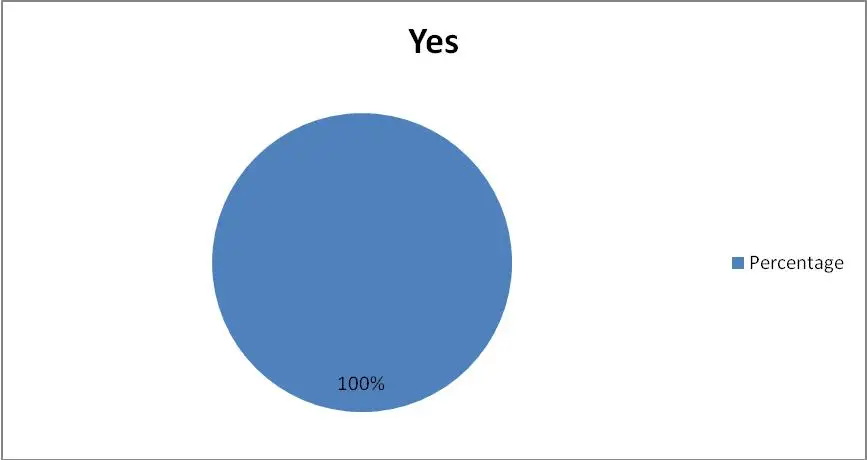
Interpretation:Table 1 reveals that all the respondents are drinking cold drinks.
2). How frequently you buy cold drink?
a. Once a day
b. Twice a day
c. More than twice
d. Not regular
| Once a day | 30 | 30% |
| Twice a day | 4 | 4% |
| More than twice | 2 | 2% |
| Not regular drunker | 64 | 64% |
| Total | 100 | 100% |
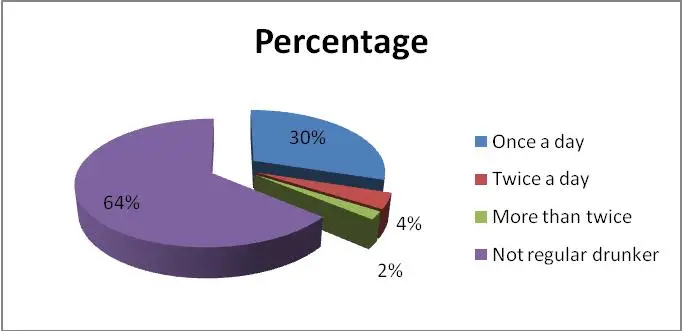
Interpretation: Table 2 represents that 30% of the respondents drink it once a day, 4% twice a day, 2% more than twice and 32% drink it no regularly.
3). Which cold drink do you like themost?
a. Coca-Cola
b.Pepsi.
c. Limca.
d. Fanta
e.Thums-up
f. Mirinda
g. Canada Dry
h. Maaza
| Coca cola | 12 | 12% |
| Pepsi | 12 | 12% |
| Fanta | 15 | 15% |
| Limca | 7 | 7% |
| Mirinda | 10 | 10% |
| Thums-up | 10 | 10% |
| Canada dry | 4 | 4% |
| Maaza | 30 | 30% |
| Total | 100 | 100% |
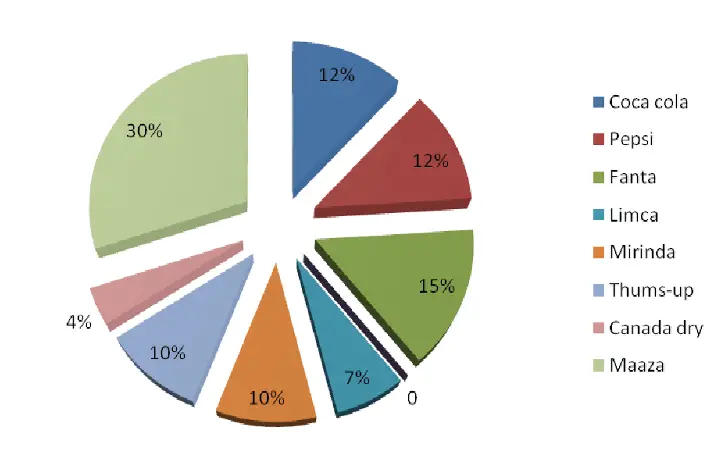
Interpretation: Table 3: Indicate that out of 100 respondents 120 like Coca cola, 120 like Pepsi,70 like Limca, 10 like Fanta, 10 like Mirinda, 10 0like Thums-up, 40 like Canada dry and 30 like Maaza.
4). Whichflavor of cold drink you like the most?
a. Cola.
b. Lemon.
c.Mango.
d.Orange.
e.Others
| Flavors | No. of respondents | Percentage | |
| Cola | 60 | 60% | |
| Lemon | 14 | 14% | |
| Orange | 14 | 14% | |
| Mango | 4 | 4% | |
| Others | 8 | 8% | |
| Total | 100 | 100% |
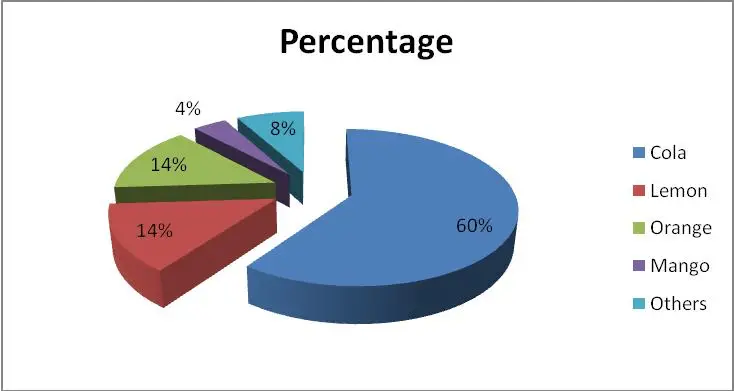
Interpretation:Table 4 shows that out of 60% of the respondents like the cola flavor of colddrink, 14% like the Lemon flavor and same percentage of respondents like the orange flavor of cold drink.
5). Have you seen the advertisement of cold drink whichyou like the most?
a. Yes
b. No
| Yes | 96 | 96% |
| No | 4 | 4% |
| Total | 100 | 100% |
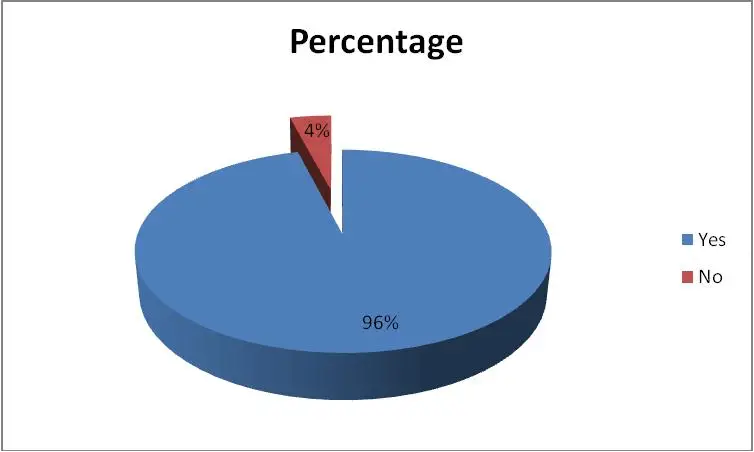
Interpretation:Table indicate that 96% of the respondents are of the view that they have beenthe advertisement of the cold drink they like most while 4% shows that they don‘t have seen the advertisement.
6). Where have you seen it?
a. T.V.
b. News Paper
c. Magazine
d. Others
| TV | 92 | 92% |
| Newspaper | 4 | 4% |
| Magazine | 2 | 2% |
| Other | 2 | 2% |
| Total | 100 | 100% |
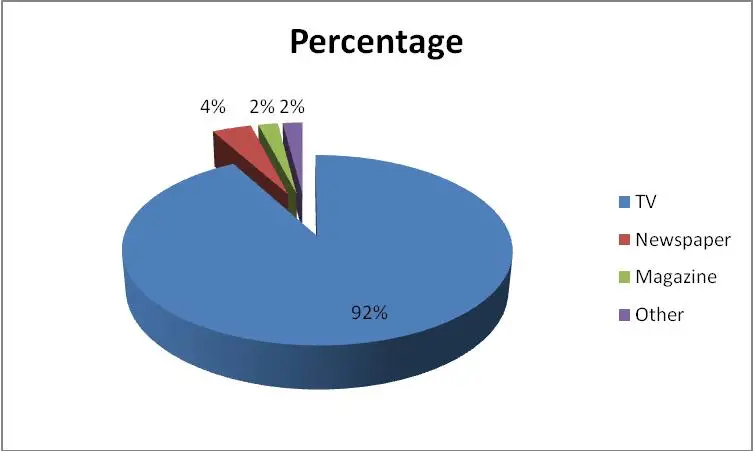
Interpretation: Table 6 reveals that 92% of the respondents are of opinion that they have seen the advertisement on TV while 4% are of the opinion that they have seen the advertisement in newspaper.
7). Which slogan of cold drink you like themost?
a. Taste the Thunder
b. Yara Da Tashan
c. YehDil Mange More
d. Jo chahe ho Jai COCA-COLA enjoy
| Taste the thunder | 24 | 24% |
| Yara Da tashan | 28 | 28% |
| Yehdil mange more | 32 | 32% |
| Jo chahe ho jaye, coca cola enjoy | 16 | 16% |
| Total | 100 | 100 |
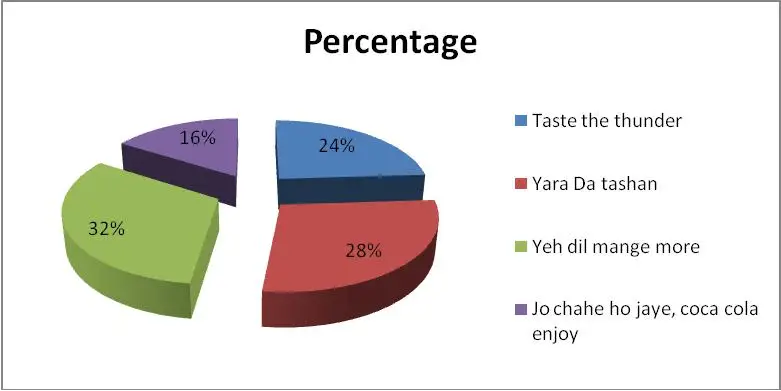
Interpretation: Table 7 shows that out of 50 respondents 12 like the slogan ‘taste the thunder’,14 like ‘Yara da tashan’, 16 like ‘yehdil mange more’ and 8 like the slogan ‘Jo caahe ho jayecocacolaenjoy‘.
8). Why do you like the advertisement?
a. Because it has film stars?
b. It‘s theme and making is appealable.
c. Because of Good music
d. Any other reason.
| Its theme and making is appealable | 60 | 60% |
| It has film stars | 14 | 14% |
| Because of good music | 14 | 14% |
| Other reasons | 12 | 12% |
| Total | 100 | 100% |
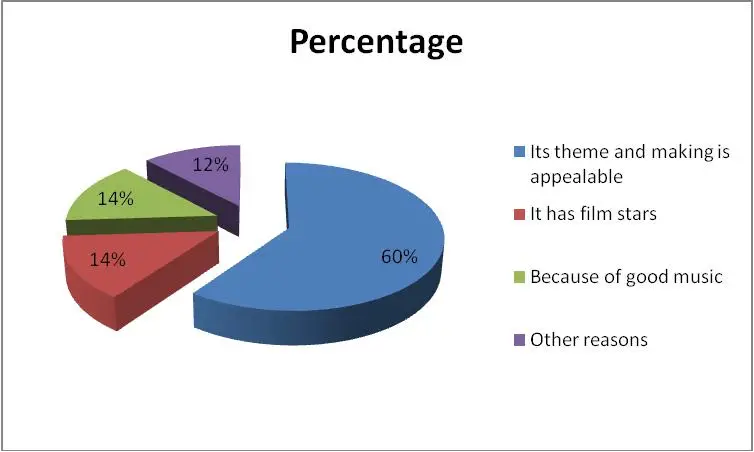
Interpretation:Table 8 shows that majority of the respondents like the advertisement due to its theme while majority of the respondents like the advertisement due to its film stars and good Music.
9). Do you think that advertisement has forced you to consume more product ?
a. Yes
b. No
c. Can‘t say
| Yes | 46 | 46% |
| No | 34 | 34% |
| Can‘t say | 20 | 20% |
| Total | 100 | 100% |

Interpretation: Table 9 shows that 46% of the respondents are of the view that advertisement forced them to consume product more 34% of them has view that advertisement don‘t force them to consume the product while 20% of them cannot say anything about it.
10). Which media is more effective for advertisement for sale of cold drink?
a. TV
b. News Paper
c. Magazine
d. Other
| TV | 84 | 84% | ||
| Newspaper | 4 | 4% | ||
| Magazine | 8 | 8% | ||
| Others | 4 | 4% | ||
| Total | 100 | 100% |
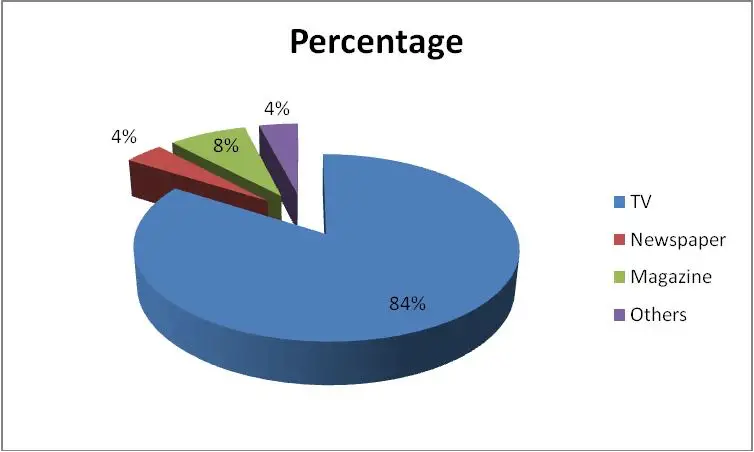
Interpretation: Table 10 reveals that 84% of the respondents are of the view that presently theTV is most effective media of advertisement.
11). Do you think the advertisement is necessary for sale of cold drink?
a. Necessary
b. Very Necessary
c. Not Necessary
d. Cant Say
| Necessary | 28 | 28% |
| Very necessary | 68 | 68% |
| Can‘t say | 4 | 4% |
| Total | 100 | 100% |
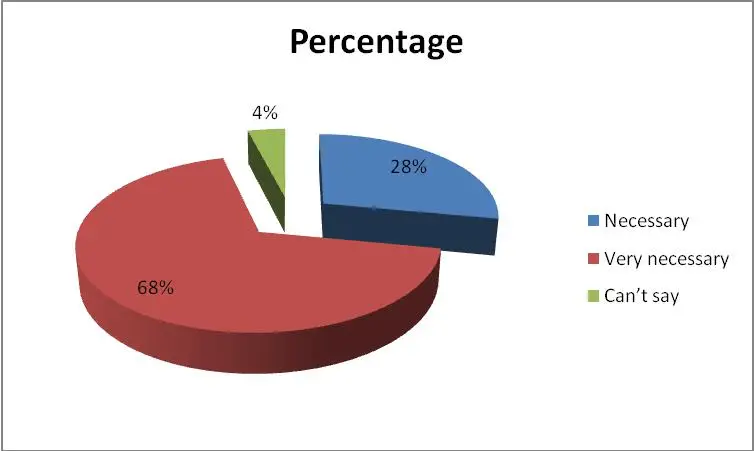
Interpretation:Table 11 shows that highest number of respondents is of the view that advertisement is very necessary for cold drinks while few respondents are of the view that advertisement is necessary.
12). Does the expenditure incurred on the advertisement of cold drink is such effective that it adds to profit?
a. Yes
b. No
c. Can’t Say
| Yes | 86 | 86% |
| No | 4 | 4% |
| Can‘t say | 10 | 10% |
| Total | 100 | 100% |
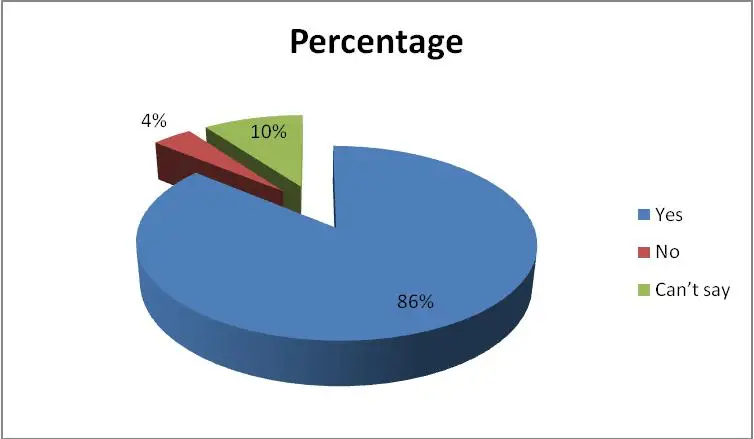
Interpretation: Table 12 shows that 86% of the respondents are of the view that the expenditure incurred on advertisement is effective in adding the profit while 4% denied the same and 10% did not reply.
13) Is the study of effectiveness contributes to improvement in present advertisement?
a. Yes
b. No
c. Can’t Say
| Yes | 90 | 90% |
| No | 2 | 2% |
| Cannot say | 10 | 10% |
| Total | 100 | 100% |
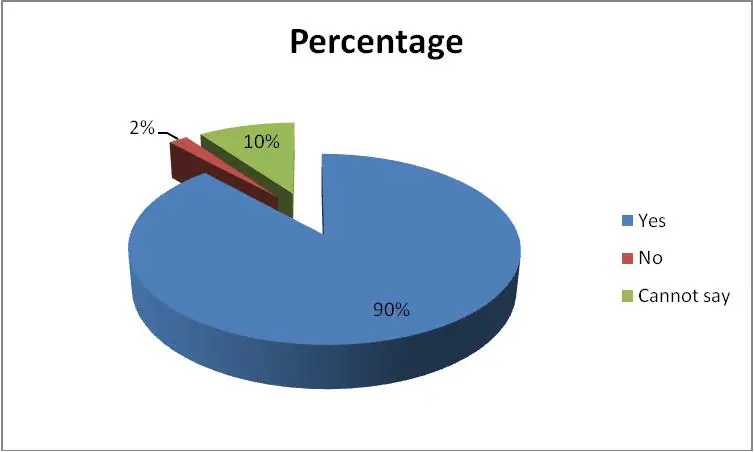
Interpretation: Table 13 shows that the majority of the respondents are of the view that the studyof effectiveness contributes the improvement in the present advertisement.
14. Is advertisement effectiveness is necessary for the company?
a. Yes
b. No
c. Can’t Say
| Yes | 96 | 96% |
| No | 2 | 2% |
| Can‘t say | 2 | 2% |
| Total | 100 | 100% |
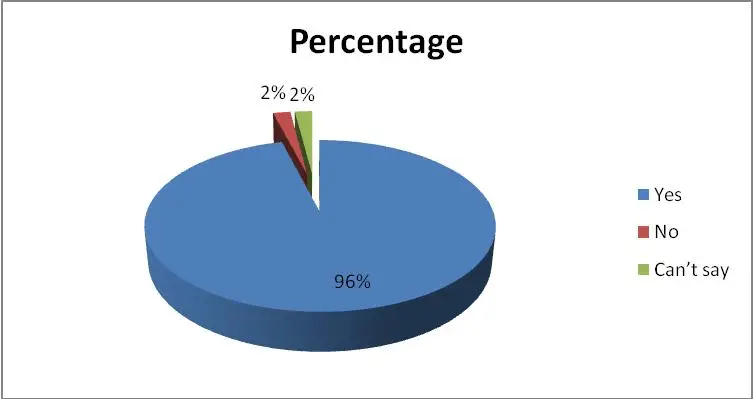
Interpretation: Table 14 reveals that majority of the respondents say that the advertisement effectiveness is necessary while same did not reply.
FINDINGS
After going through the entire project and the collected data, I found that:
- The 84% of the respondents said that TV is the most effective media of advertisement.
- The 60% of the respondents said that they like the advertisement of cold drinks because of its theme whereas, 14% said that they like celebrities in advertisement.
- Majority of respondents are of the view that advertisement is very necessary for cold drink.
- Majority of respondents sees the advertisement of the cold drink they like most.
- Majority of the respondents like cola flavor of cold drink.
- Equal number of respondents likes the brand of Coca Cola and Pepsi.
CONCLUSIONS
Conclusion of the project report is that majority of the respondents said that TV is the most effective media for advertisement of cold drinks and they preferred to purchase that cold drink brand which celebrity endorses. Followings are the conclusion of this study—
- Majority of the respondents said that TV is the most effective media for advertising.
- Media advertisement helps in increasing the awareness and sales of company.
- It helps in making a purchasing decision of consumers.
- It helps in to find out the most popular slogan of advertisement.
SUGGESTIONS
We reached some suggestions:
- Media should be selected according to the choice of customers.
- In rural areas media should be according to the choice of the people.
- To give more attention in making the advertisement to make it effective for the sale of cold drink.
- Price should be decreased so as to attract the consumers to use product more.
- To give attention on the print media of advertisement so that the consumers comes to know about the product.
- It should be attractive one so that people are attracted toward the advertisement.
LIMITATIONS
Following are the limitations of the project report-
- Limited time and finance.
- Limited area of data collection.
- It was based on a random sample.
- The strong objection and arguments against the advertising is that it is a costly function.
- Some advertisers cleverly create a misleading impressions of their goods.
BIBLIOGRAPHY
- Prof. Jeong, Jaeseok
- Advertisement and the social roots of consumer culture .New York McGraw-Hill.
- Garret, Franklin coca cola cronical history Atlanta.
- The big drink coca cola, random house magazine.
- Ogilvy on advertising the New York Crown magazine.
- Beri G.C, Marketing Research –by Tata McGrawHill Publication, the Fourth edition.
- Kothari C R, ―Research and Methodology- Methods & Techniques‖, New Age International (P) Ltd., 2004
Credit: A Research project on “Advertising Effectiveness On Soft Drink Company Coca Cola” was completed by Akash Prabhat, BBA school of Business, Under the Supervision of Dr. Pramod Kumar Srivastava from Galgotias University Greater Noida, Uttar Pradesh.

Leave a Reply